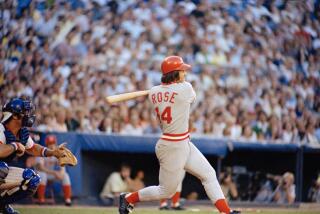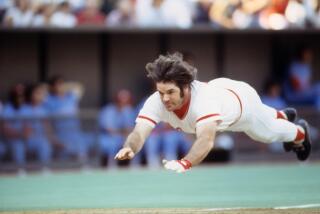Media came not to praise Bonds, but to bury Barry
When the media cover a news story with round-the-clock obsession, certain images and sound bites get repeated so often they virtually become logos for the story.
With Barry Bonds the last few days, the virtual logos have been footage of Bonds rounding the bases after his 756th home run, video clips of Bonds looking and sounding defiant, and images of sportswriters on camera denouncing baseball for âlooking the other wayâ while Bonds and others pumped up interest in the sport by pumping baseballs over outfield fences all over the country.
Baseball was hardly alone in turning a blind eye during its steroids era. With a few vigilant exceptions, the media not only jumped onto the Home Run Revival bandwagon, they also fueled it, kept the wheels in working order, rode shotgun and helped Bud Selig figure out how to make sense of the newfangled GPS satellite navigation system.
Looking back today on the 1998 home-run derby between Mark McGwire and Sammy Sosa, sports commentators refer derisively to that season as baseballâs âSummer of Love.â There is a tone of contempt as those words are uttered, as if the media knew then what they know now -- that those home runs were powered by something more than sculpted hardwood.
In July 1998, Steve Wilstein, an Associated Press sportswriter, discovered a brown jar labeled âandrostenedioneâ sitting in McGwireâs locker stall. After doing some research about androstenedione, a body-building supplement then banned by the NFL, the NCAA and the Olympics, Wilstein wrote about it on Aug. 21. He was promptly denounced by other media colleagues for âsnoopingâ and âlooking too hardâ around McGwireâs locker.
Physical evidence was staring the media in the face weeks before McGwire and Sosa entered their September stretch run in the race to break Roger Marisâ home-run record. That evidence was swept aside in the frenzy to create two new American folk heroes, to drive along this made-for-âSportsCenterâ and front-page-friendly feel-good story.
McGwire and Sosa made that happen in no small part because of their relations with the media. Sosa and his camera-ready smile were the photogenic essence of charisma. McGwire was less comfortable with the spotlight, but he made an effort to cooperate with media requests and seemed a decent guy. That notion was furthered along by the emotional approval McGwire received from members of Marisâ family.
Several sportswriter friends and I then marveled about the media love-in surrounding McGwire and Sosa. I remember saying at the time, âI wonder what would happen if somebody the media didnât like was chasing the record. Suppose Barry Bonds was chasing it.â
We laughed. In 1998, Bonds was already runaway champion in the Surliest Interview In Sports sweepstakes. He was also a high-average hitter who had managed 40 home runs in a season only three times in his first 13 seasons, including 1998, when he finished with 37 home runs.
As we saw very vividly, Bonds changed after 1998. The irony today is as thick as quicksand, but Bonds was a lock for the Hall of Fame in 1998, yet felt those accomplishments had been buried by the avalanche of happy McGwire and Sosa headlines. Bonds decided to do something about that, and assembled a personal team to help him do whatever it would take.
Nine years later, Bonds has been indicted for lying under oath about steroid use. ESPN, which has operated since 2001 under the unofficial subtitle âThe Barry Channel,â turned all its experts loose on the slugger during a âSportsCenter Specialâ report. The network that once gave us the Bonds-sanctioned pseudo-reality show âBonds on Bondsâ was now reconfiguring for the new possibility of âBonds Needs Bail Bonds.â
ESPN rolled out all sorts of interviews and talking heads, including a basketball analyst from TNT, Charles Barkley. Barkley described the Bonds case as âa selective prosecution witch huntâ spurred in part by Bondsâ prickly personality.
âThis is the only guy who has been indicted,â Barkley said, meaning baseball players whose names have been linked to steroids. âWe didnât have prosecution against Mark McGwire. We didnât have prosecution against Jason Giambi. Iâm not here to defend Barry or condone anything, but this to me, from the beginning -- they just donât like Barry Bonds.
âThey donât think heâs a nice guy. First of all, heâs not paid to be a nice guy. Heâs paid to hit home runs. Thatâs his job. Heâs the best baseball player weâve ever seen in the last 25 years, but to drag this out for four years . . .
âThey donât like Barryâs personality, because he doesnât get along well with the media, and heâs not the best guy with the fans.â
As disturbing as it is to write these words, no one during ESPNâs special report made more sense than Stephen A. Smith.
Smith said the Bonds prosecution was selective because âhe was chasing the all-time home-run record and the federal government saw it as an opportunity to make a huge statement and they wanted to take advantage of that.
âI do believe it was also selective in regards to timing. Because I think if this was the late â90s, I donât believe it would have been the case . . . because Mark McGwire was chasing Roger Marisâ single-season all-time home-run record just four years removed from the World Series cancellation. They were trying to resurrect the sport.
âI think a lot of people knew then that steroids [were] prevalent in the sport. They turned a blind eye and a deaf ear to it.â
On the same day the Bonds indictments came down, baseball announced revenue of $6.075 billion this year. We can consider the sport resurrected. The timing was right for a steroids indictment, and Bonds was the right kind of antihero needed for a sport seeking conditions safe enough to finally take a stand.
--
More to Read
Go beyond the scoreboard
Get the latest on L.A.'s teams in the daily Sports Report newsletter.
You may occasionally receive promotional content from the Los Angeles Times.










